BSBADM502: Manage Meetings - Assessment Guide and Checklist
VerifiedAdded on 2021/02/20
|37
|7693
|98
Homework Assignment
AI Summary
This document serves as a comprehensive assessment guide for the BSBADM502 unit, focusing on managing meetings. It outlines the elements of competency, foundation skills, and performance evidence required for successful completion. The guide details assessment requirements, including learner workbook activities, observation checklists, major activities, skills and knowledge activities, and third-party assessments. It emphasizes the importance of preparing for meetings by developing agendas, identifying participants, and confirming arrangements. It also covers conducting meetings effectively, ensuring focus, time efficiency, and achieving desired outcomes. The assessment includes various tools such as observation/demonstration checklists, and third-party reports. Furthermore, it provides guidelines for instructors on conducting assessments, including adjusting methods to accommodate students' needs. This document is essential for students seeking to understand the assessment process and achieve competency in managing meetings, with a focus on practical application and demonstration of skills.

1. Name: _________________________
Paraphrase This Document
Need a fresh take? Get an instant paraphrase of this document with our AI Paraphraser
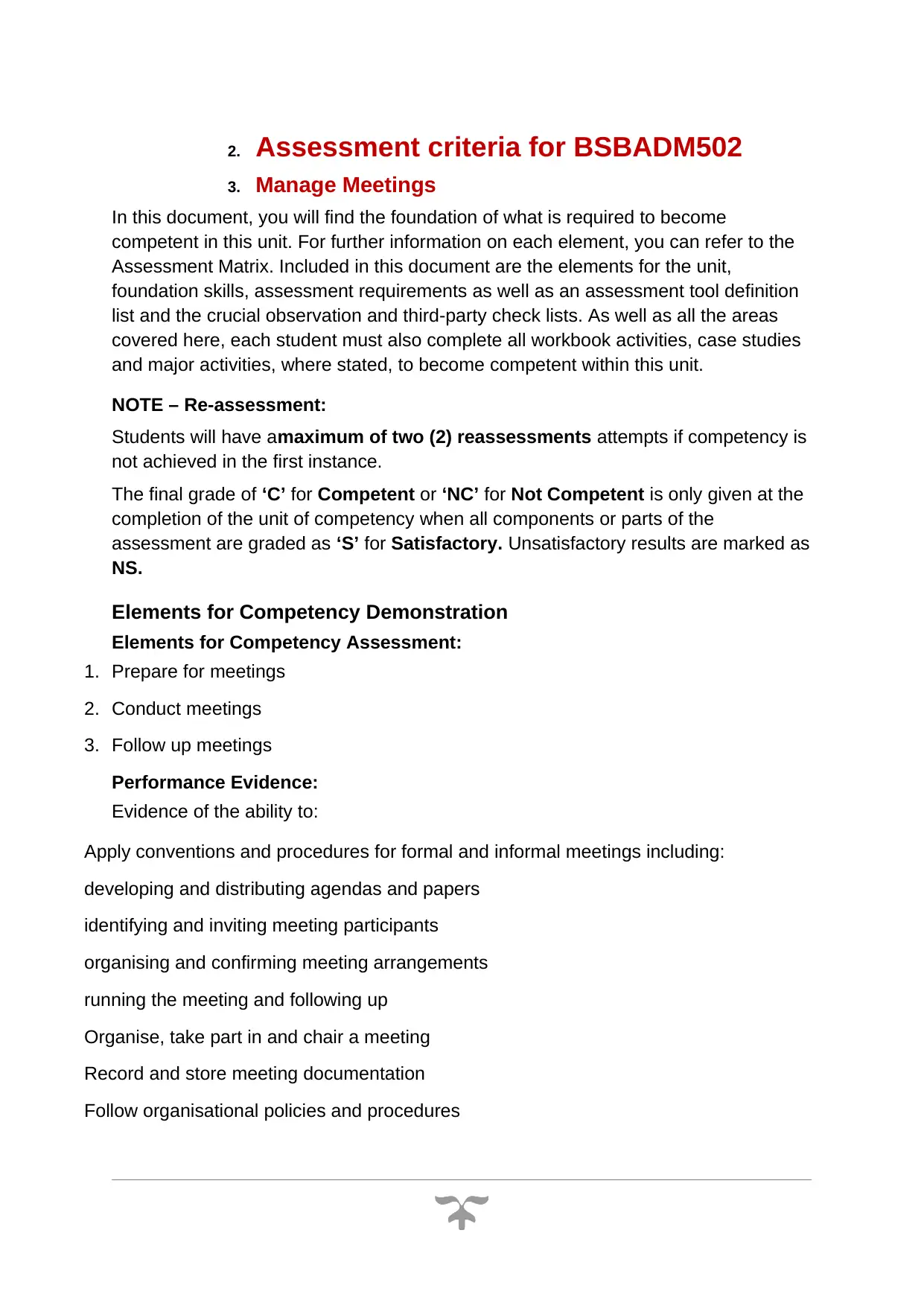
2. Assessment criteria for BSBADM502
3. Manage Meetings
In this document, you will find the foundation of what is required to become
competent in this unit. For further information on each element, you can refer to the
Assessment Matrix. Included in this document are the elements for the unit,
foundation skills, assessment requirements as well as an assessment tool definition
list and the crucial observation and third-party check lists. As well as all the areas
covered here, each student must also complete all workbook activities, case studies
and major activities, where stated, to become competent within this unit.
NOTE – Re-assessment:
Students will have amaximum of two (2) reassessments attempts if competency is
not achieved in the first instance.
The final grade of ‘C’ for Competent or ‘NC’ for Not Competent is only given at the
completion of the unit of competency when all components or parts of the
assessment are graded as ‘S’ for Satisfactory. Unsatisfactory results are marked as
NS.
Elements for Competency Demonstration
Elements for Competency Assessment:
1. Prepare for meetings
2. Conduct meetings
3. Follow up meetings
Performance Evidence:
Evidence of the ability to:
Apply conventions and procedures for formal and informal meetings including:
developing and distributing agendas and papers
identifying and inviting meeting participants
organising and confirming meeting arrangements
running the meeting and following up
Organise, take part in and chair a meeting
Record and store meeting documentation
Follow organisational policies and procedures
3. Manage Meetings
In this document, you will find the foundation of what is required to become
competent in this unit. For further information on each element, you can refer to the
Assessment Matrix. Included in this document are the elements for the unit,
foundation skills, assessment requirements as well as an assessment tool definition
list and the crucial observation and third-party check lists. As well as all the areas
covered here, each student must also complete all workbook activities, case studies
and major activities, where stated, to become competent within this unit.
NOTE – Re-assessment:
Students will have amaximum of two (2) reassessments attempts if competency is
not achieved in the first instance.
The final grade of ‘C’ for Competent or ‘NC’ for Not Competent is only given at the
completion of the unit of competency when all components or parts of the
assessment are graded as ‘S’ for Satisfactory. Unsatisfactory results are marked as
NS.
Elements for Competency Demonstration
Elements for Competency Assessment:
1. Prepare for meetings
2. Conduct meetings
3. Follow up meetings
Performance Evidence:
Evidence of the ability to:
Apply conventions and procedures for formal and informal meetings including:
developing and distributing agendas and papers
identifying and inviting meeting participants
organising and confirming meeting arrangements
running the meeting and following up
Organise, take part in and chair a meeting
Record and store meeting documentation
Follow organisational policies and procedures
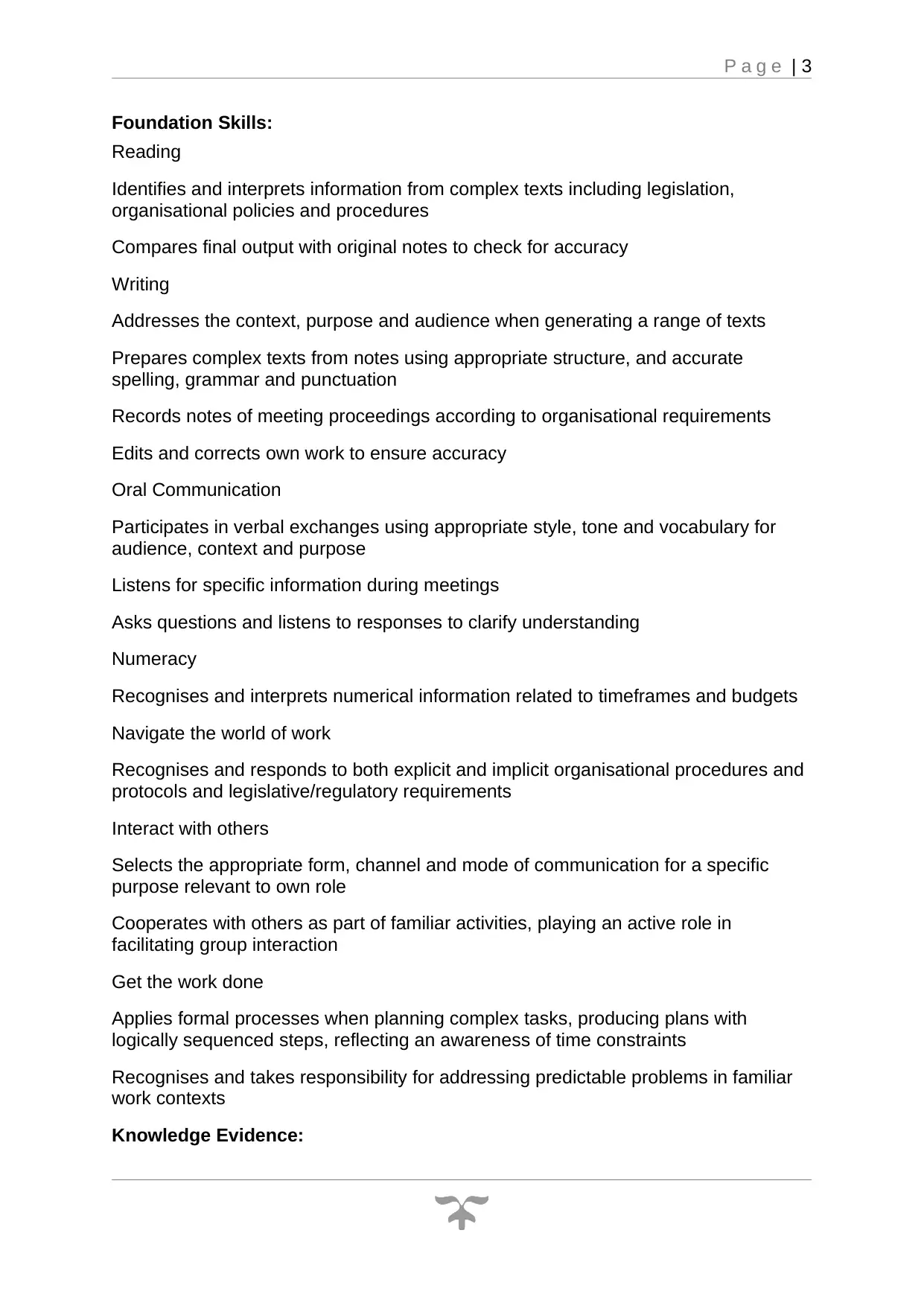
P a g e | 3
Foundation Skills:
Reading
Identifies and interprets information from complex texts including legislation,
organisational policies and procedures
Compares final output with original notes to check for accuracy
Writing
Addresses the context, purpose and audience when generating a range of texts
Prepares complex texts from notes using appropriate structure, and accurate
spelling, grammar and punctuation
Records notes of meeting proceedings according to organisational requirements
Edits and corrects own work to ensure accuracy
Oral Communication
Participates in verbal exchanges using appropriate style, tone and vocabulary for
audience, context and purpose
Listens for specific information during meetings
Asks questions and listens to responses to clarify understanding
Numeracy
Recognises and interprets numerical information related to timeframes and budgets
Navigate the world of work
Recognises and responds to both explicit and implicit organisational procedures and
protocols and legislative/regulatory requirements
Interact with others
Selects the appropriate form, channel and mode of communication for a specific
purpose relevant to own role
Cooperates with others as part of familiar activities, playing an active role in
facilitating group interaction
Get the work done
Applies formal processes when planning complex tasks, producing plans with
logically sequenced steps, reflecting an awareness of time constraints
Recognises and takes responsibility for addressing predictable problems in familiar
work contexts
Knowledge Evidence:
Foundation Skills:
Reading
Identifies and interprets information from complex texts including legislation,
organisational policies and procedures
Compares final output with original notes to check for accuracy
Writing
Addresses the context, purpose and audience when generating a range of texts
Prepares complex texts from notes using appropriate structure, and accurate
spelling, grammar and punctuation
Records notes of meeting proceedings according to organisational requirements
Edits and corrects own work to ensure accuracy
Oral Communication
Participates in verbal exchanges using appropriate style, tone and vocabulary for
audience, context and purpose
Listens for specific information during meetings
Asks questions and listens to responses to clarify understanding
Numeracy
Recognises and interprets numerical information related to timeframes and budgets
Navigate the world of work
Recognises and responds to both explicit and implicit organisational procedures and
protocols and legislative/regulatory requirements
Interact with others
Selects the appropriate form, channel and mode of communication for a specific
purpose relevant to own role
Cooperates with others as part of familiar activities, playing an active role in
facilitating group interaction
Get the work done
Applies formal processes when planning complex tasks, producing plans with
logically sequenced steps, reflecting an awareness of time constraints
Recognises and takes responsibility for addressing predictable problems in familiar
work contexts
Knowledge Evidence:
⊘ This is a preview!⊘
Do you want full access?
Subscribe today to unlock all pages.

Trusted by 1+ million students worldwide
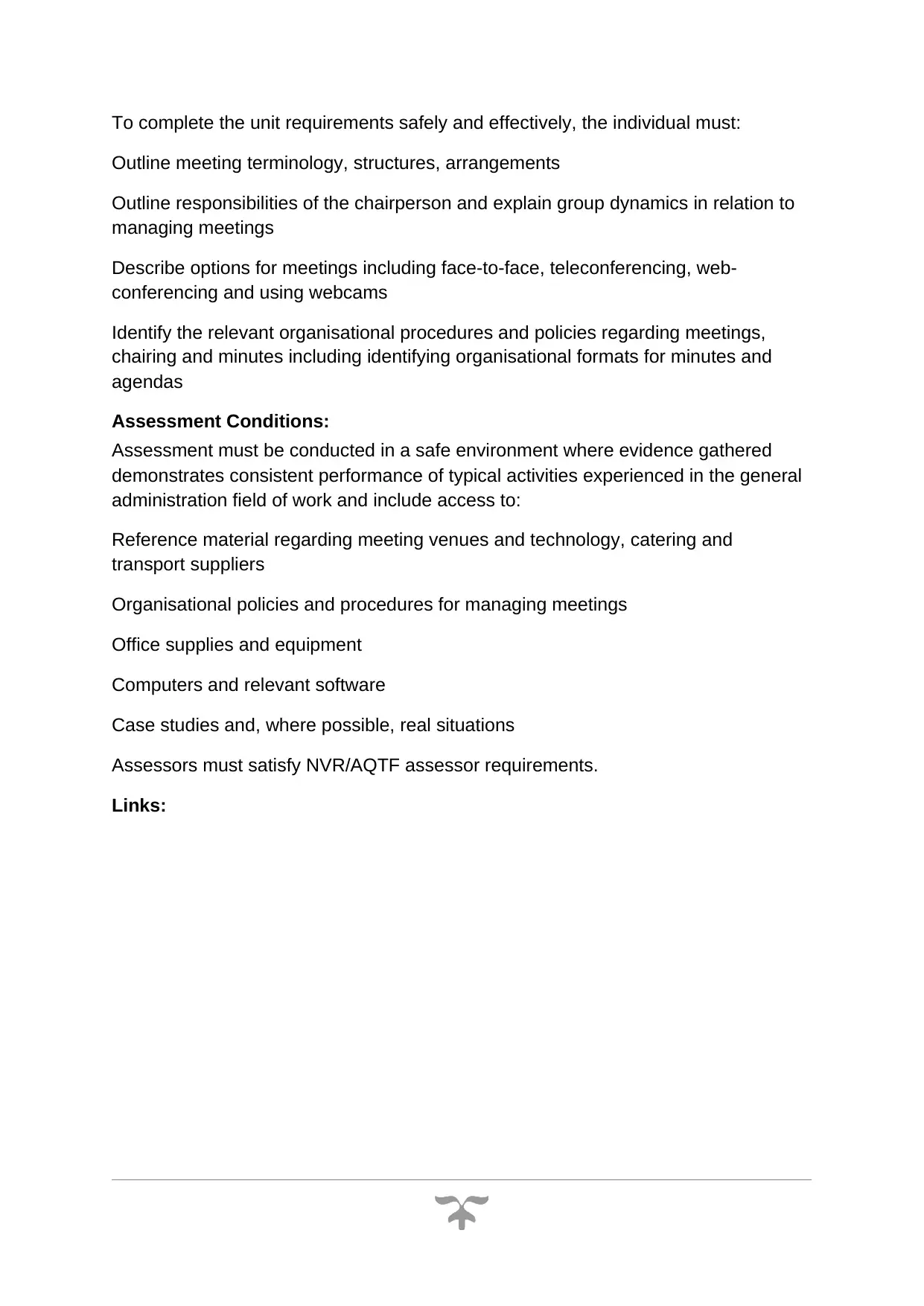
To complete the unit requirements safely and effectively, the individual must:
Outline meeting terminology, structures, arrangements
Outline responsibilities of the chairperson and explain group dynamics in relation to
managing meetings
Describe options for meetings including face-to-face, teleconferencing, web-
conferencing and using webcams
Identify the relevant organisational procedures and policies regarding meetings,
chairing and minutes including identifying organisational formats for minutes and
agendas
Assessment Conditions:
Assessment must be conducted in a safe environment where evidence gathered
demonstrates consistent performance of typical activities experienced in the general
administration field of work and include access to:
Reference material regarding meeting venues and technology, catering and
transport suppliers
Organisational policies and procedures for managing meetings
Office supplies and equipment
Computers and relevant software
Case studies and, where possible, real situations
Assessors must satisfy NVR/AQTF assessor requirements.
Links:
Outline meeting terminology, structures, arrangements
Outline responsibilities of the chairperson and explain group dynamics in relation to
managing meetings
Describe options for meetings including face-to-face, teleconferencing, web-
conferencing and using webcams
Identify the relevant organisational procedures and policies regarding meetings,
chairing and minutes including identifying organisational formats for minutes and
agendas
Assessment Conditions:
Assessment must be conducted in a safe environment where evidence gathered
demonstrates consistent performance of typical activities experienced in the general
administration field of work and include access to:
Reference material regarding meeting venues and technology, catering and
transport suppliers
Organisational policies and procedures for managing meetings
Office supplies and equipment
Computers and relevant software
Case studies and, where possible, real situations
Assessors must satisfy NVR/AQTF assessor requirements.
Links:
Paraphrase This Document
Need a fresh take? Get an instant paraphrase of this document with our AI Paraphraser
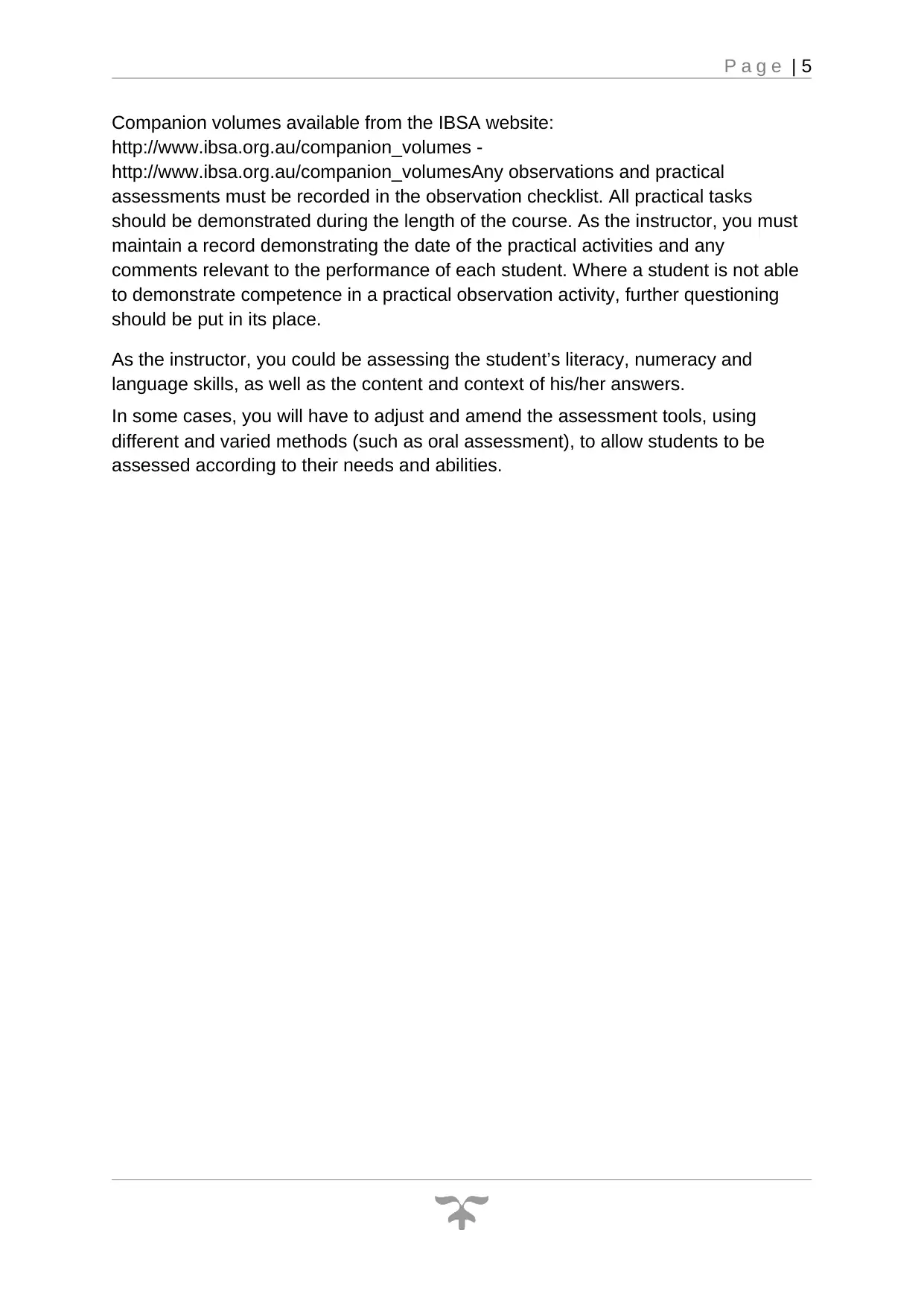
P a g e | 5
Companion volumes available from the IBSA website:
http://www.ibsa.org.au/companion_volumes -
http://www.ibsa.org.au/companion_volumesAny observations and practical
assessments must be recorded in the observation checklist. All practical tasks
should be demonstrated during the length of the course. As the instructor, you must
maintain a record demonstrating the date of the practical activities and any
comments relevant to the performance of each student. Where a student is not able
to demonstrate competence in a practical observation activity, further questioning
should be put in its place.
As the instructor, you could be assessing the student’s literacy, numeracy and
language skills, as well as the content and context of his/her answers.
In some cases, you will have to adjust and amend the assessment tools, using
different and varied methods (such as oral assessment), to allow students to be
assessed according to their needs and abilities.
Companion volumes available from the IBSA website:
http://www.ibsa.org.au/companion_volumes -
http://www.ibsa.org.au/companion_volumesAny observations and practical
assessments must be recorded in the observation checklist. All practical tasks
should be demonstrated during the length of the course. As the instructor, you must
maintain a record demonstrating the date of the practical activities and any
comments relevant to the performance of each student. Where a student is not able
to demonstrate competence in a practical observation activity, further questioning
should be put in its place.
As the instructor, you could be assessing the student’s literacy, numeracy and
language skills, as well as the content and context of his/her answers.
In some cases, you will have to adjust and amend the assessment tools, using
different and varied methods (such as oral assessment), to allow students to be
assessed according to their needs and abilities.
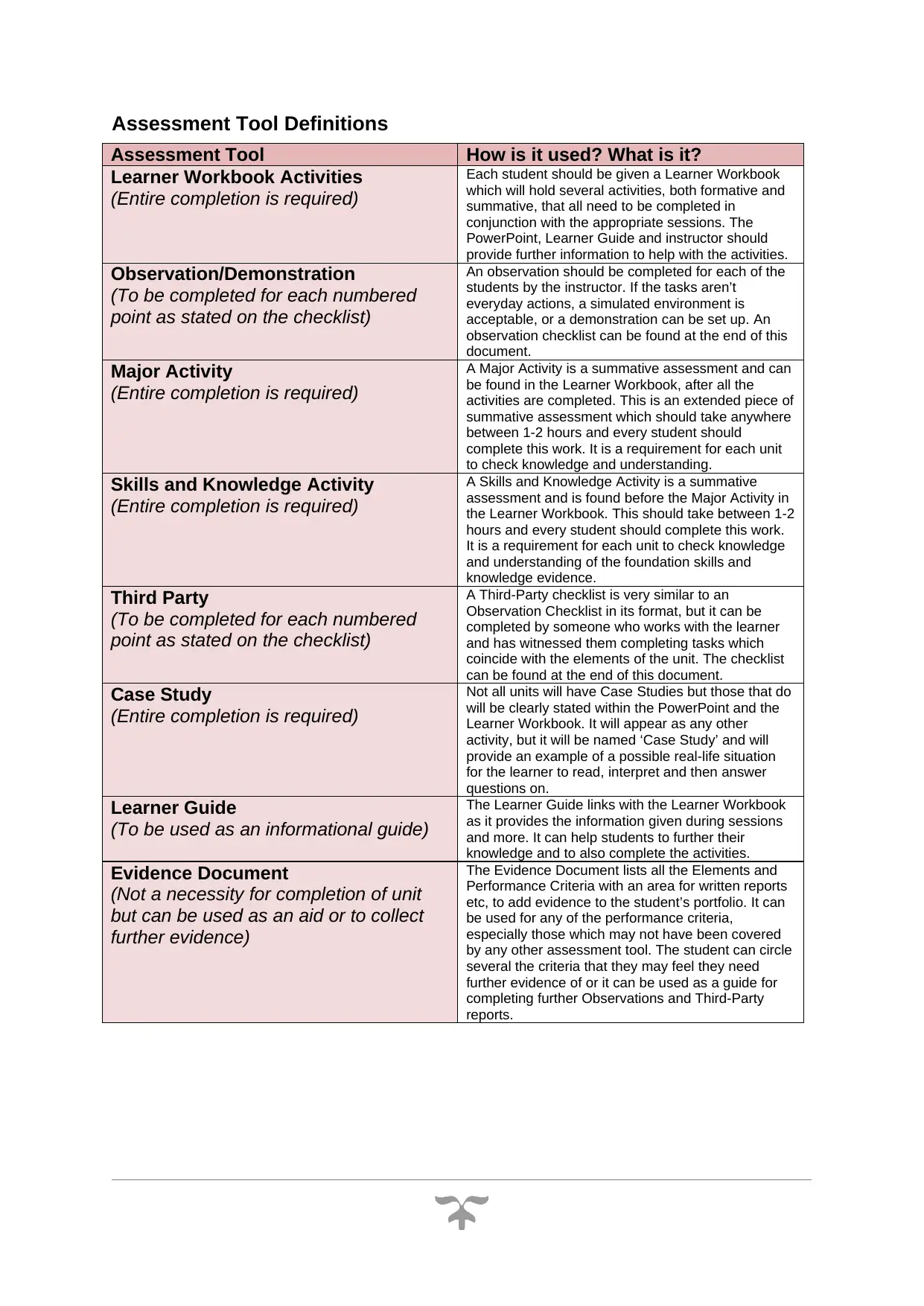
Assessment Tool Definitions
Assessment Tool How is it used? What is it?
Learner Workbook Activities
(Entire completion is required)
Each student should be given a Learner Workbook
which will hold several activities, both formative and
summative, that all need to be completed in
conjunction with the appropriate sessions. The
PowerPoint, Learner Guide and instructor should
provide further information to help with the activities.
Observation/Demonstration
(To be completed for each numbered
point as stated on the checklist)
An observation should be completed for each of the
students by the instructor. If the tasks aren’t
everyday actions, a simulated environment is
acceptable, or a demonstration can be set up. An
observation checklist can be found at the end of this
document.
Major Activity
(Entire completion is required)
A Major Activity is a summative assessment and can
be found in the Learner Workbook, after all the
activities are completed. This is an extended piece of
summative assessment which should take anywhere
between 1-2 hours and every student should
complete this work. It is a requirement for each unit
to check knowledge and understanding.
Skills and Knowledge Activity
(Entire completion is required)
A Skills and Knowledge Activity is a summative
assessment and is found before the Major Activity in
the Learner Workbook. This should take between 1-2
hours and every student should complete this work.
It is a requirement for each unit to check knowledge
and understanding of the foundation skills and
knowledge evidence.
Third Party
(To be completed for each numbered
point as stated on the checklist)
A Third-Party checklist is very similar to an
Observation Checklist in its format, but it can be
completed by someone who works with the learner
and has witnessed them completing tasks which
coincide with the elements of the unit. The checklist
can be found at the end of this document.
Case Study
(Entire completion is required)
Not all units will have Case Studies but those that do
will be clearly stated within the PowerPoint and the
Learner Workbook. It will appear as any other
activity, but it will be named ‘Case Study’ and will
provide an example of a possible real-life situation
for the learner to read, interpret and then answer
questions on.
Learner Guide
(To be used as an informational guide)
The Learner Guide links with the Learner Workbook
as it provides the information given during sessions
and more. It can help students to further their
knowledge and to also complete the activities.
Evidence Document
(Not a necessity for completion of unit
but can be used as an aid or to collect
further evidence)
The Evidence Document lists all the Elements and
Performance Criteria with an area for written reports
etc, to add evidence to the student’s portfolio. It can
be used for any of the performance criteria,
especially those which may not have been covered
by any other assessment tool. The student can circle
several the criteria that they may feel they need
further evidence of or it can be used as a guide for
completing further Observations and Third-Party
reports.
Assessment Tool How is it used? What is it?
Learner Workbook Activities
(Entire completion is required)
Each student should be given a Learner Workbook
which will hold several activities, both formative and
summative, that all need to be completed in
conjunction with the appropriate sessions. The
PowerPoint, Learner Guide and instructor should
provide further information to help with the activities.
Observation/Demonstration
(To be completed for each numbered
point as stated on the checklist)
An observation should be completed for each of the
students by the instructor. If the tasks aren’t
everyday actions, a simulated environment is
acceptable, or a demonstration can be set up. An
observation checklist can be found at the end of this
document.
Major Activity
(Entire completion is required)
A Major Activity is a summative assessment and can
be found in the Learner Workbook, after all the
activities are completed. This is an extended piece of
summative assessment which should take anywhere
between 1-2 hours and every student should
complete this work. It is a requirement for each unit
to check knowledge and understanding.
Skills and Knowledge Activity
(Entire completion is required)
A Skills and Knowledge Activity is a summative
assessment and is found before the Major Activity in
the Learner Workbook. This should take between 1-2
hours and every student should complete this work.
It is a requirement for each unit to check knowledge
and understanding of the foundation skills and
knowledge evidence.
Third Party
(To be completed for each numbered
point as stated on the checklist)
A Third-Party checklist is very similar to an
Observation Checklist in its format, but it can be
completed by someone who works with the learner
and has witnessed them completing tasks which
coincide with the elements of the unit. The checklist
can be found at the end of this document.
Case Study
(Entire completion is required)
Not all units will have Case Studies but those that do
will be clearly stated within the PowerPoint and the
Learner Workbook. It will appear as any other
activity, but it will be named ‘Case Study’ and will
provide an example of a possible real-life situation
for the learner to read, interpret and then answer
questions on.
Learner Guide
(To be used as an informational guide)
The Learner Guide links with the Learner Workbook
as it provides the information given during sessions
and more. It can help students to further their
knowledge and to also complete the activities.
Evidence Document
(Not a necessity for completion of unit
but can be used as an aid or to collect
further evidence)
The Evidence Document lists all the Elements and
Performance Criteria with an area for written reports
etc, to add evidence to the student’s portfolio. It can
be used for any of the performance criteria,
especially those which may not have been covered
by any other assessment tool. The student can circle
several the criteria that they may feel they need
further evidence of or it can be used as a guide for
completing further Observations and Third-Party
reports.
⊘ This is a preview!⊘
Do you want full access?
Subscribe today to unlock all pages.

Trusted by 1+ million students worldwide
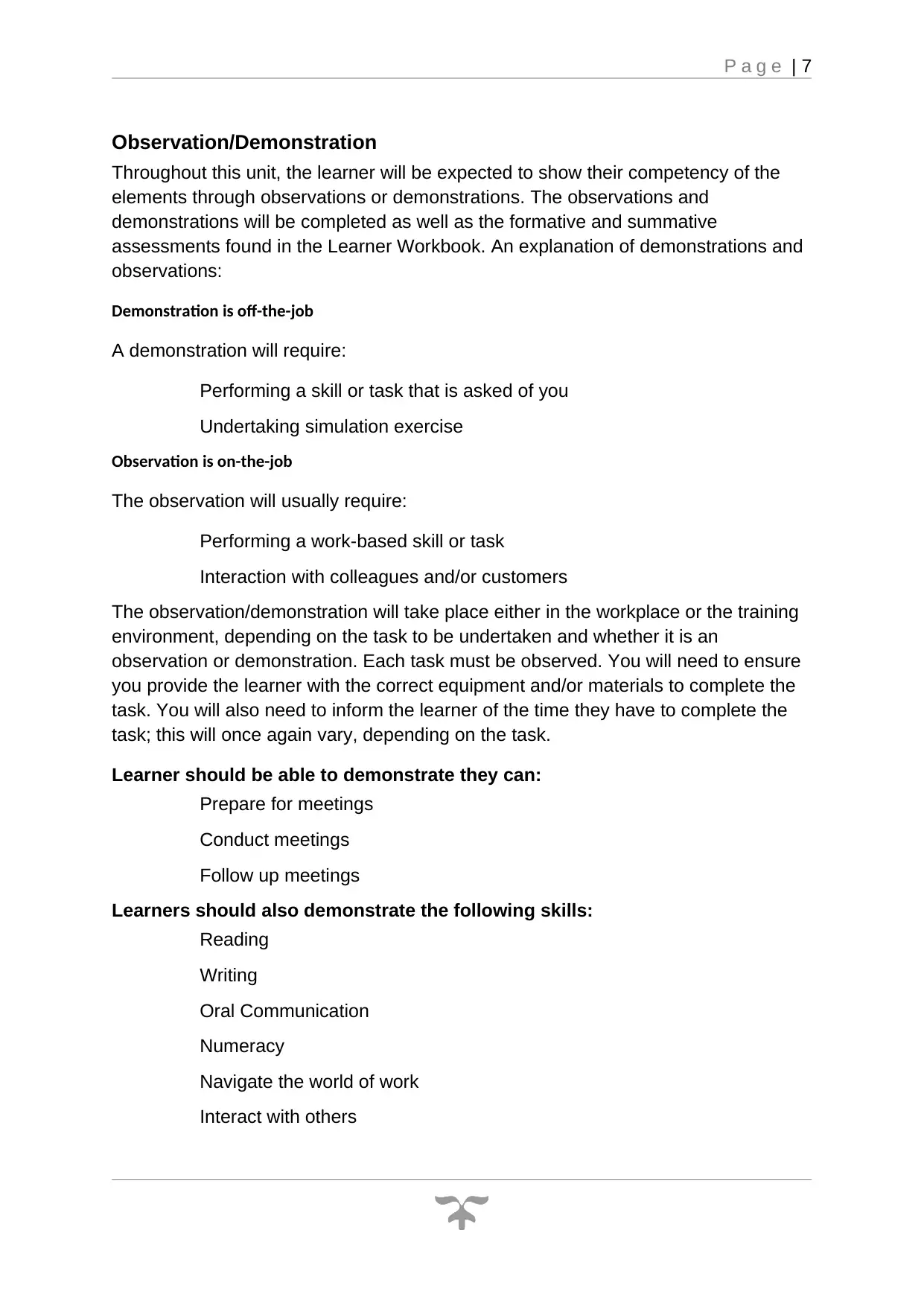
P a g e | 7
Observation/Demonstration
Throughout this unit, the learner will be expected to show their competency of the
elements through observations or demonstrations. The observations and
demonstrations will be completed as well as the formative and summative
assessments found in the Learner Workbook. An explanation of demonstrations and
observations:
Demonstration is off-the-job
A demonstration will require:
Performing a skill or task that is asked of you
Undertaking simulation exercise
Observation is on-the-job
The observation will usually require:
Performing a work-based skill or task
Interaction with colleagues and/or customers
The observation/demonstration will take place either in the workplace or the training
environment, depending on the task to be undertaken and whether it is an
observation or demonstration. Each task must be observed. You will need to ensure
you provide the learner with the correct equipment and/or materials to complete the
task. You will also need to inform the learner of the time they have to complete the
task; this will once again vary, depending on the task.
Learner should be able to demonstrate they can:
Prepare for meetings
Conduct meetings
Follow up meetings
Learners should also demonstrate the following skills:
Reading
Writing
Oral Communication
Numeracy
Navigate the world of work
Interact with others
Observation/Demonstration
Throughout this unit, the learner will be expected to show their competency of the
elements through observations or demonstrations. The observations and
demonstrations will be completed as well as the formative and summative
assessments found in the Learner Workbook. An explanation of demonstrations and
observations:
Demonstration is off-the-job
A demonstration will require:
Performing a skill or task that is asked of you
Undertaking simulation exercise
Observation is on-the-job
The observation will usually require:
Performing a work-based skill or task
Interaction with colleagues and/or customers
The observation/demonstration will take place either in the workplace or the training
environment, depending on the task to be undertaken and whether it is an
observation or demonstration. Each task must be observed. You will need to ensure
you provide the learner with the correct equipment and/or materials to complete the
task. You will also need to inform the learner of the time they have to complete the
task; this will once again vary, depending on the task.
Learner should be able to demonstrate they can:
Prepare for meetings
Conduct meetings
Follow up meetings
Learners should also demonstrate the following skills:
Reading
Writing
Oral Communication
Numeracy
Navigate the world of work
Interact with others
Paraphrase This Document
Need a fresh take? Get an instant paraphrase of this document with our AI Paraphraser
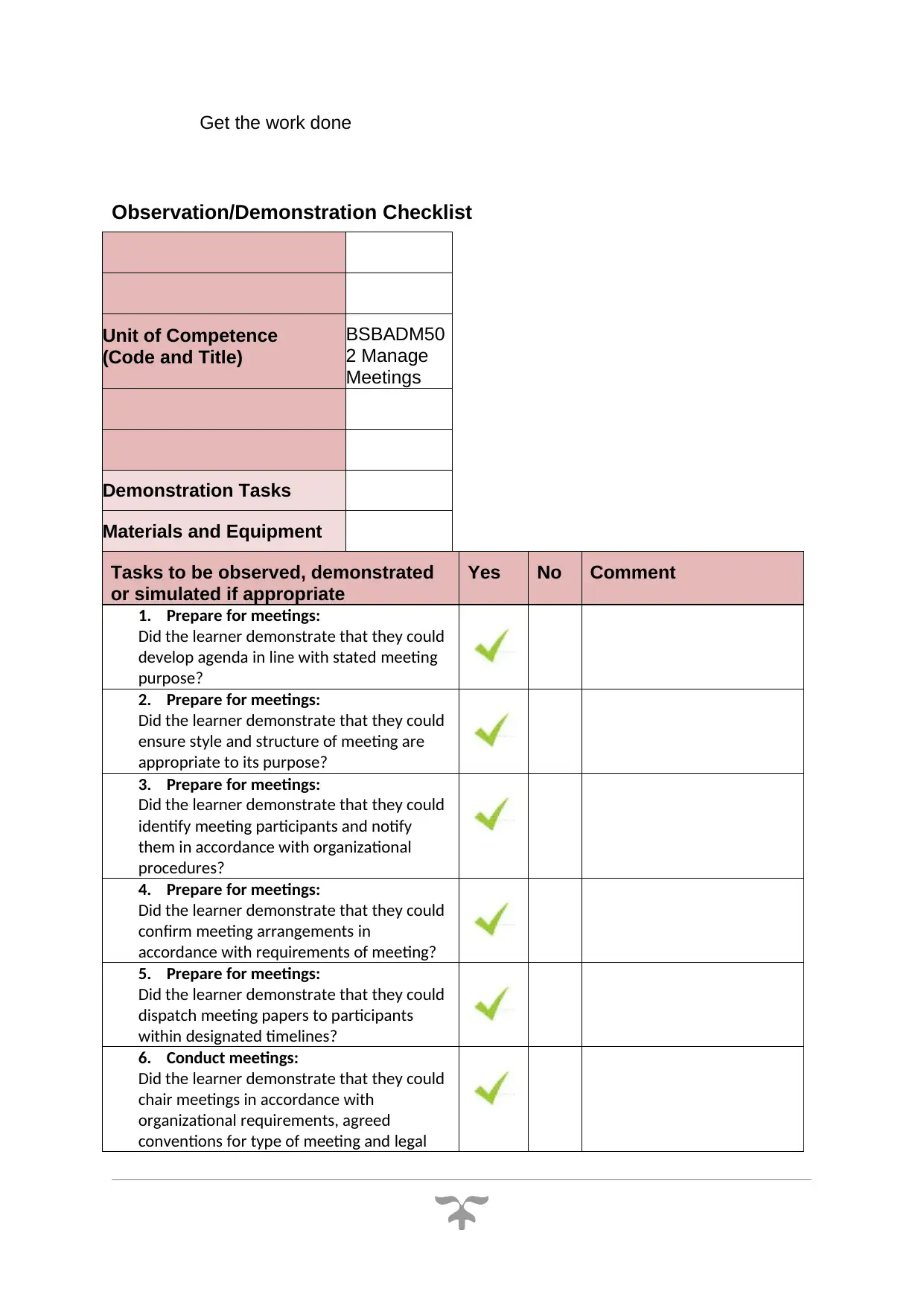
Get the work done
Observation/Demonstration Checklist
Unit of Competence
(Code and Title)
BSBADM50
2 Manage
Meetings
Demonstration Tasks
Materials and Equipment
Tasks to be observed, demonstrated
or simulated if appropriate
Yes No Comment
1. Prepare for meetings:
Did the learner demonstrate that they could
develop agenda in line with stated meeting
purpose?
2. Prepare for meetings:
Did the learner demonstrate that they could
ensure style and structure of meeting are
appropriate to its purpose?
3. Prepare for meetings:
Did the learner demonstrate that they could
identify meeting participants and notify
them in accordance with organizational
procedures?
4. Prepare for meetings:
Did the learner demonstrate that they could
confirm meeting arrangements in
accordance with requirements of meeting?
5. Prepare for meetings:
Did the learner demonstrate that they could
dispatch meeting papers to participants
within designated timelines?
6. Conduct meetings:
Did the learner demonstrate that they could
chair meetings in accordance with
organizational requirements, agreed
conventions for type of meeting and legal
Observation/Demonstration Checklist
Unit of Competence
(Code and Title)
BSBADM50
2 Manage
Meetings
Demonstration Tasks
Materials and Equipment
Tasks to be observed, demonstrated
or simulated if appropriate
Yes No Comment
1. Prepare for meetings:
Did the learner demonstrate that they could
develop agenda in line with stated meeting
purpose?
2. Prepare for meetings:
Did the learner demonstrate that they could
ensure style and structure of meeting are
appropriate to its purpose?
3. Prepare for meetings:
Did the learner demonstrate that they could
identify meeting participants and notify
them in accordance with organizational
procedures?
4. Prepare for meetings:
Did the learner demonstrate that they could
confirm meeting arrangements in
accordance with requirements of meeting?
5. Prepare for meetings:
Did the learner demonstrate that they could
dispatch meeting papers to participants
within designated timelines?
6. Conduct meetings:
Did the learner demonstrate that they could
chair meetings in accordance with
organizational requirements, agreed
conventions for type of meeting and legal
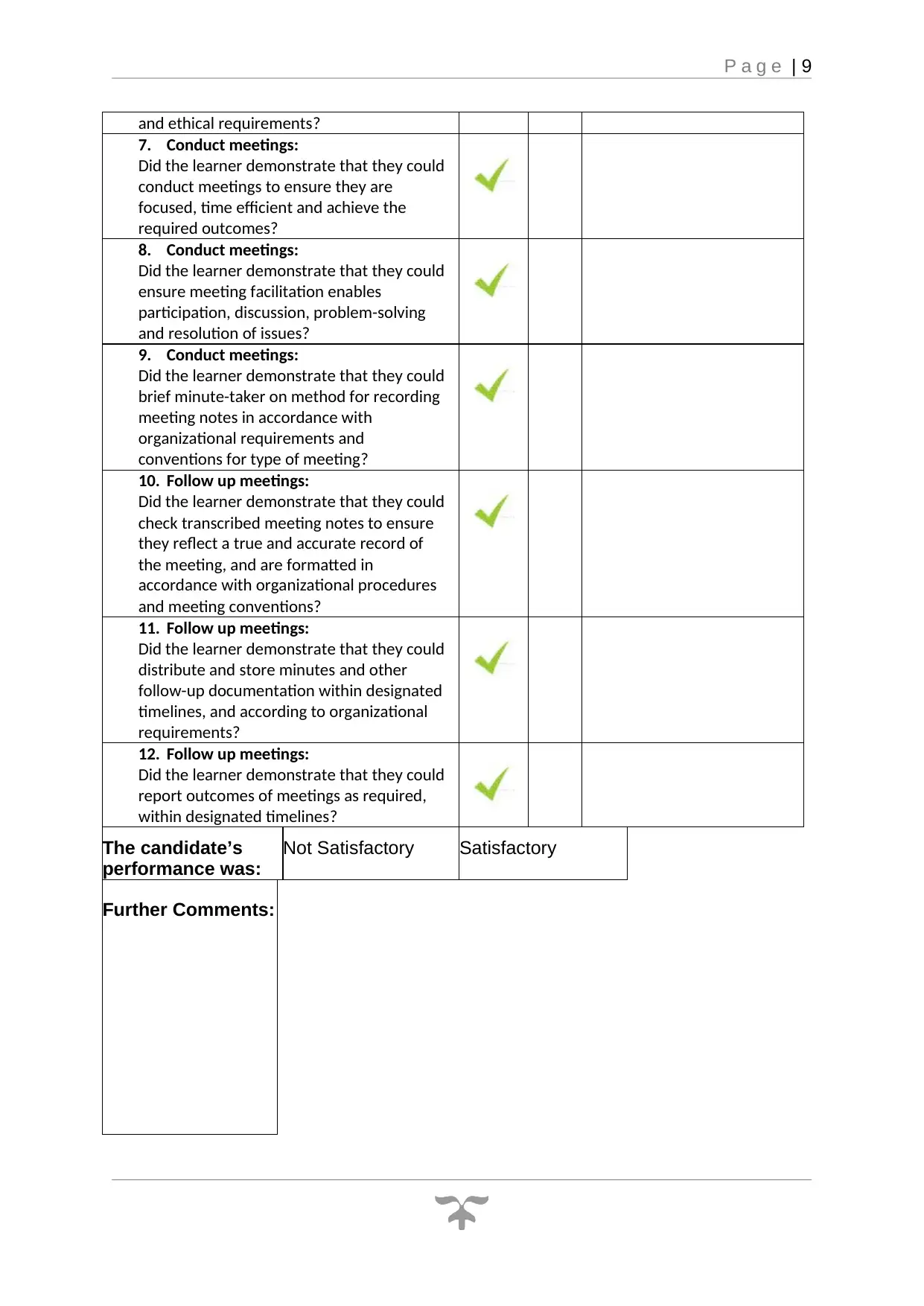
P a g e | 9
and ethical requirements?
7. Conduct meetings:
Did the learner demonstrate that they could
conduct meetings to ensure they are
focused, time efficient and achieve the
required outcomes?
8. Conduct meetings:
Did the learner demonstrate that they could
ensure meeting facilitation enables
participation, discussion, problem-solving
and resolution of issues?
9. Conduct meetings:
Did the learner demonstrate that they could
brief minute-taker on method for recording
meeting notes in accordance with
organizational requirements and
conventions for type of meeting?
10. Follow up meetings:
Did the learner demonstrate that they could
check transcribed meeting notes to ensure
they reflect a true and accurate record of
the meeting, and are formatted in
accordance with organizational procedures
and meeting conventions?
11. Follow up meetings:
Did the learner demonstrate that they could
distribute and store minutes and other
follow-up documentation within designated
timelines, and according to organizational
requirements?
12. Follow up meetings:
Did the learner demonstrate that they could
report outcomes of meetings as required,
within designated timelines?
The candidate’s
performance was:
Not Satisfactory Satisfactory
Further Comments:
and ethical requirements?
7. Conduct meetings:
Did the learner demonstrate that they could
conduct meetings to ensure they are
focused, time efficient and achieve the
required outcomes?
8. Conduct meetings:
Did the learner demonstrate that they could
ensure meeting facilitation enables
participation, discussion, problem-solving
and resolution of issues?
9. Conduct meetings:
Did the learner demonstrate that they could
brief minute-taker on method for recording
meeting notes in accordance with
organizational requirements and
conventions for type of meeting?
10. Follow up meetings:
Did the learner demonstrate that they could
check transcribed meeting notes to ensure
they reflect a true and accurate record of
the meeting, and are formatted in
accordance with organizational procedures
and meeting conventions?
11. Follow up meetings:
Did the learner demonstrate that they could
distribute and store minutes and other
follow-up documentation within designated
timelines, and according to organizational
requirements?
12. Follow up meetings:
Did the learner demonstrate that they could
report outcomes of meetings as required,
within designated timelines?
The candidate’s
performance was:
Not Satisfactory Satisfactory
Further Comments:
⊘ This is a preview!⊘
Do you want full access?
Subscribe today to unlock all pages.

Trusted by 1+ million students worldwide

Paraphrase This Document
Need a fresh take? Get an instant paraphrase of this document with our AI Paraphraser
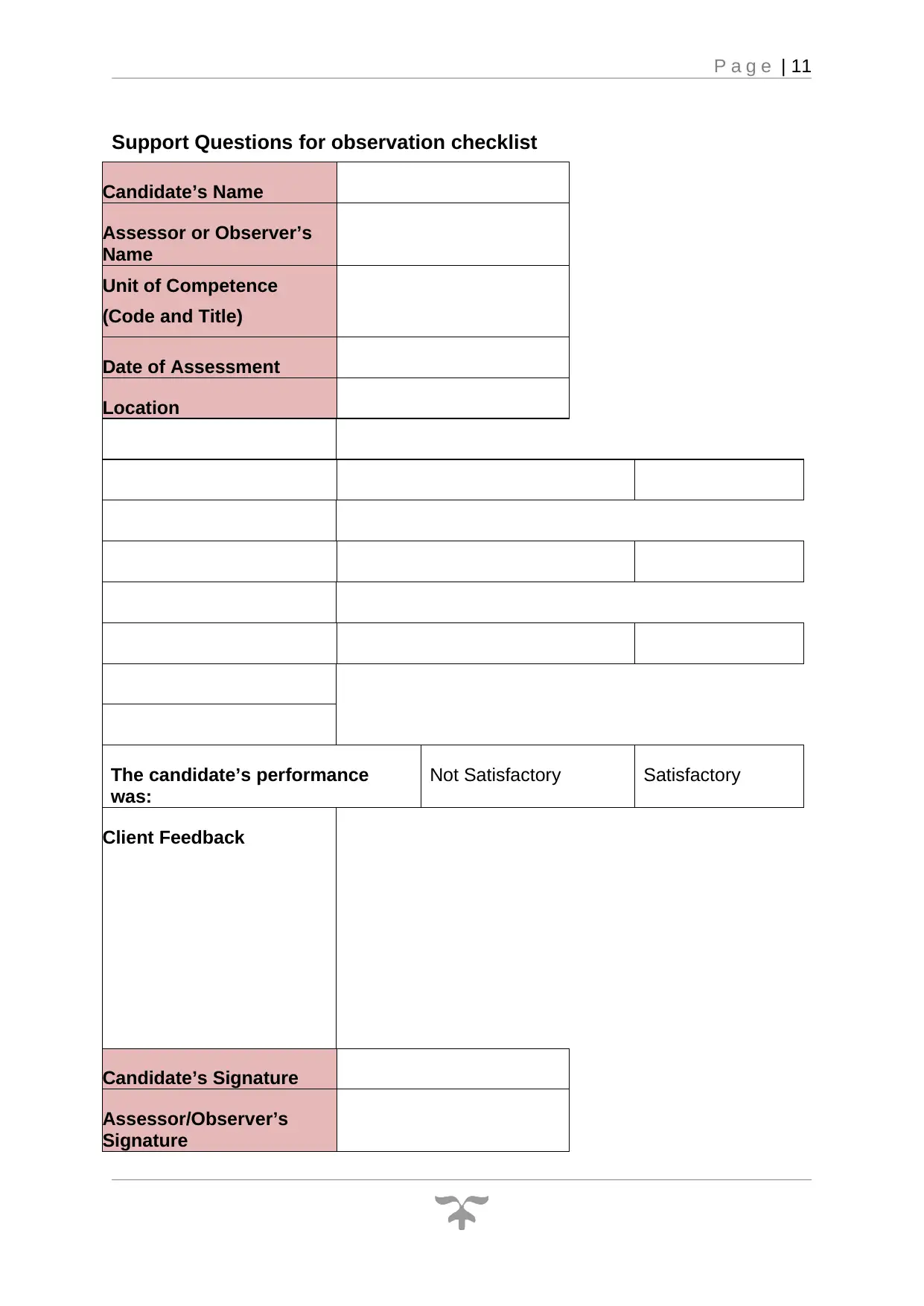
P a g e | 11
Support Questions for observation checklist
Candidate’s Name
Assessor or Observer’s
Name
Unit of Competence
(Code and Title)
Date of Assessment
Location
The candidate’s performance
was:
Not Satisfactory Satisfactory
Client Feedback
Candidate’s Signature
Assessor/Observer’s
Signature
Support Questions for observation checklist
Candidate’s Name
Assessor or Observer’s
Name
Unit of Competence
(Code and Title)
Date of Assessment
Location
The candidate’s performance
was:
Not Satisfactory Satisfactory
Client Feedback
Candidate’s Signature
Assessor/Observer’s
Signature
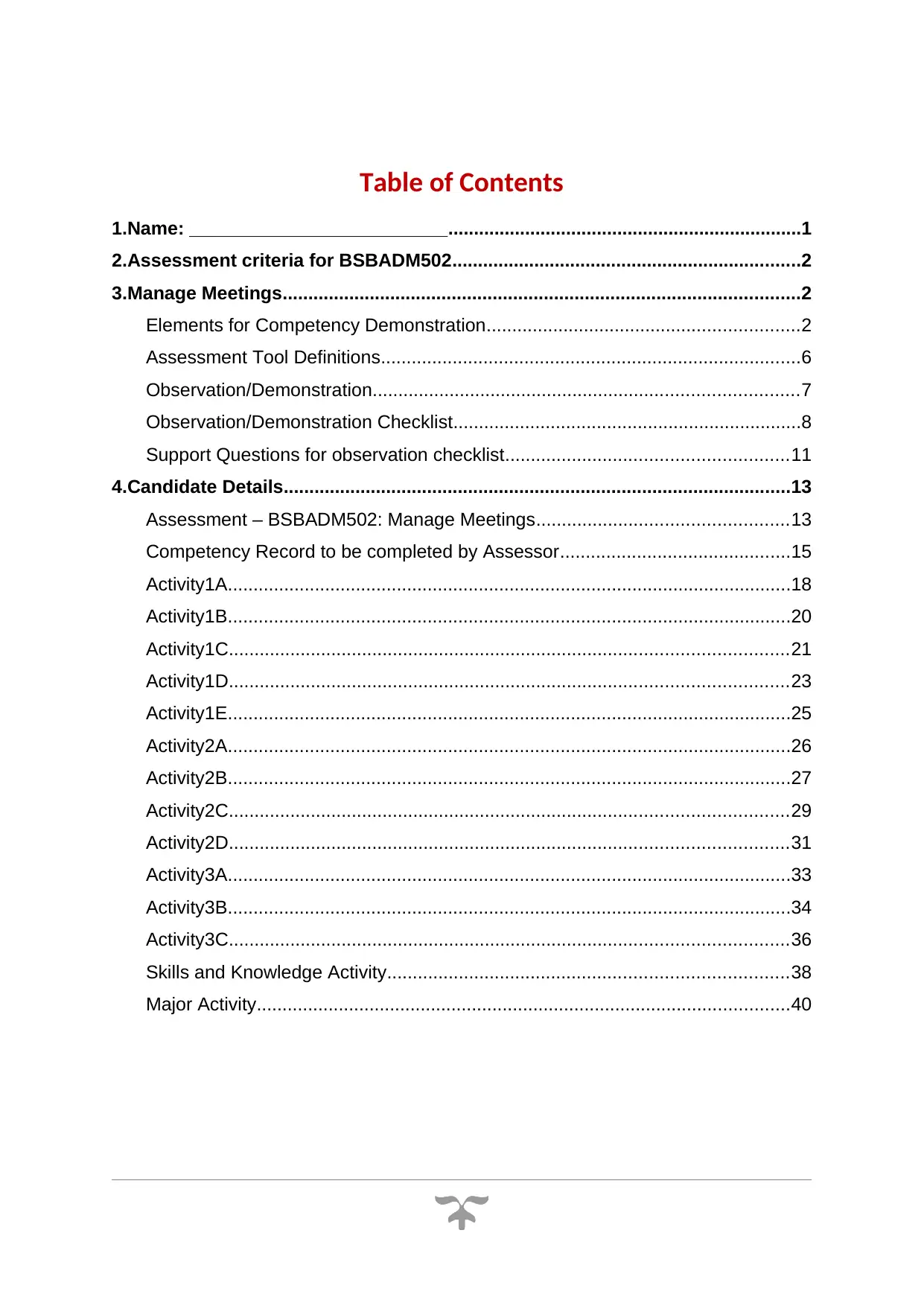
Table of Contents
1.Name: _________________________.....................................................................1
2.Assessment criteria for BSBADM502....................................................................2
3.Manage Meetings.....................................................................................................2
Elements for Competency Demonstration.............................................................2
Assessment Tool Definitions..................................................................................6
Observation/Demonstration...................................................................................7
Observation/Demonstration Checklist....................................................................8
Support Questions for observation checklist.......................................................11
4.Candidate Details...................................................................................................13
Assessment – BSBADM502: Manage Meetings.................................................13
Competency Record to be completed by Assessor.............................................15
Activity1A..............................................................................................................18
Activity1B..............................................................................................................20
Activity1C.............................................................................................................21
Activity1D.............................................................................................................23
Activity1E..............................................................................................................25
Activity2A..............................................................................................................26
Activity2B..............................................................................................................27
Activity2C.............................................................................................................29
Activity2D.............................................................................................................31
Activity3A..............................................................................................................33
Activity3B..............................................................................................................34
Activity3C.............................................................................................................36
Skills and Knowledge Activity..............................................................................38
Major Activity........................................................................................................40
1.Name: _________________________.....................................................................1
2.Assessment criteria for BSBADM502....................................................................2
3.Manage Meetings.....................................................................................................2
Elements for Competency Demonstration.............................................................2
Assessment Tool Definitions..................................................................................6
Observation/Demonstration...................................................................................7
Observation/Demonstration Checklist....................................................................8
Support Questions for observation checklist.......................................................11
4.Candidate Details...................................................................................................13
Assessment – BSBADM502: Manage Meetings.................................................13
Competency Record to be completed by Assessor.............................................15
Activity1A..............................................................................................................18
Activity1B..............................................................................................................20
Activity1C.............................................................................................................21
Activity1D.............................................................................................................23
Activity1E..............................................................................................................25
Activity2A..............................................................................................................26
Activity2B..............................................................................................................27
Activity2C.............................................................................................................29
Activity2D.............................................................................................................31
Activity3A..............................................................................................................33
Activity3B..............................................................................................................34
Activity3C.............................................................................................................36
Skills and Knowledge Activity..............................................................................38
Major Activity........................................................................................................40
⊘ This is a preview!⊘
Do you want full access?
Subscribe today to unlock all pages.

Trusted by 1+ million students worldwide
1 out of 37
Related Documents
Your All-in-One AI-Powered Toolkit for Academic Success.
+13062052269
info@desklib.com
Available 24*7 on WhatsApp / Email
![[object Object]](/_next/static/media/star-bottom.7253800d.svg)
Unlock your academic potential
Copyright © 2020–2025 A2Z Services. All Rights Reserved. Developed and managed by ZUCOL.




